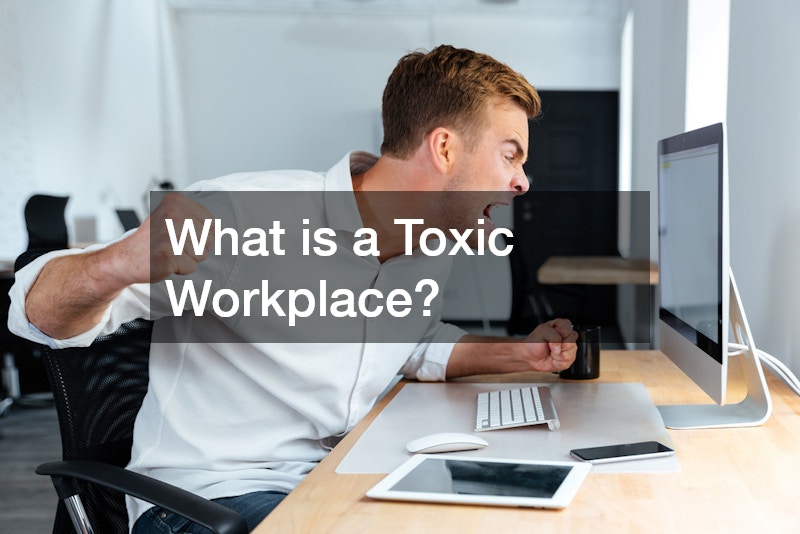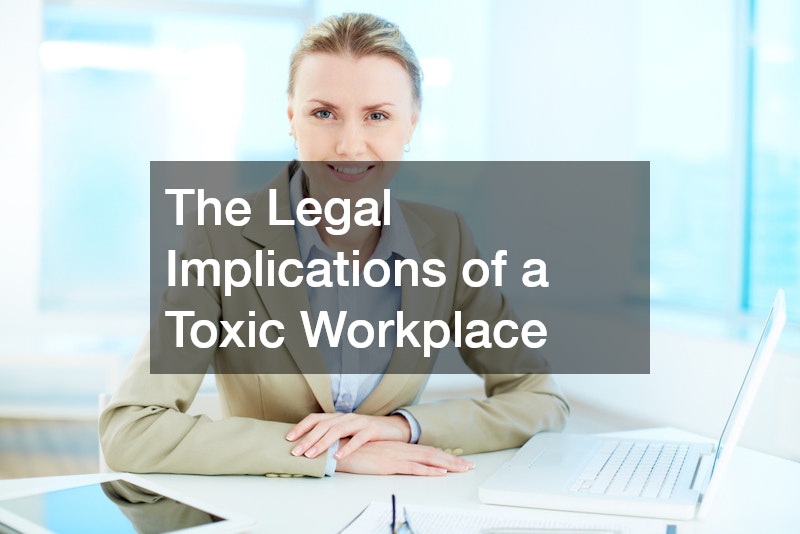Workplaces should be places of collaboration, growth, and respect. Unfortunately, that’s not always the case. Some environments turn toxic—where negative behaviors, poor leadership, or harmful practices make it difficult for employees to thrive.
For employees, recognizing the signs of a toxic workplace isn’t just about protecting your mental health—it’s also about knowing when workplace conditions might cross into illegal territory. For employers, understanding these signs can help prevent costly lawsuits and improve employee retention.
This guide will cover:
- How to identify signs of a toxic workplace
- The potential legal implications of these behaviors
- Practical steps you can take to protect yourself and your rights
- When it’s time to seek legal advice
What is a Toxic Workplace?

A toxic workplace is an environment where patterns of behavior, management style, or company culture harm employees’ well-being. This can affect mental health, physical health, and even career progression.
While some toxic behaviors are simply bad management, others can cross into harassment, discrimination, or violations of labor laws—issues that may have legal consequences.
Common characteristics of a toxic workplace include:
- Ongoing patterns of disrespect or hostility
- Poor communication from leadership
- Lack of transparency in decision-making
- Overwork and unreasonable expectations
- Ignoring or dismissing complaints
Clear Signs of a Toxic Workplace
A. Constant High Stress and Burnout
If employees feel exhausted, overwhelmed, or fearful about work every day, it could be a sign the environment is damaging their well-being. While some jobs are naturally high-pressure, ongoing burnout often points to poor workload management or unrealistic expectations.
Possible legal angle: If stress is caused by excessive unpaid overtime, it may violate wage and hour laws.
B. Bullying or Harassment
Harassment can be verbal, physical, or psychological. This includes:
- Insults or name-calling
- Intimidation tactics
- Spreading rumors or gossip
- Public humiliation
Legal angle: Harassment based on race, gender, age, religion, disability, or other protected characteristics can be illegal under employment discrimination laws.
C. Discrimination in Opportunities
If promotions, training, or key assignments consistently go to certain groups while others are excluded without valid reasons, it’s a red flag.
Legal angle: Discrimination in hiring, promotions, or pay may violate Equal Employment Opportunity (EEO) laws.
D. High Turnover Rates
A toxic workplace often has trouble keeping employees. If people keep leaving for similar reasons—such as management style, lack of respect, or overwork—it signals deeper cultural problems.
E. Lack of Work-Life Balance
Consistently expecting employees to work late, skip breaks, or be available 24/7 creates long-term harm.
Legal angle: Denying legally mandated breaks or requiring unpaid overtime can be grounds for legal action.
F. Fear of Speaking Up
If employees feel they can’t report problems without retaliation, it shows a lack of trust and accountability.
Legal angle: Retaliating against employees for reporting workplace issues may violate whistleblower or labor protection laws.
The Legal Implications of a Toxic Workplace

A toxic environment doesn’t always break the law, but certain behaviors can. Understanding where workplace toxicity becomes a legal matter is important.
Potential legal violations include:
- Harassment – Behavior that creates a hostile work environment based on a protected characteristic.
- Discrimination – Unequal treatment in hiring, pay, promotions, or termination.
- Retaliation – Punishing an employee for filing a complaint or whistleblowing.
- Wage & Hour Violations – Denying overtime pay or breaks.
- Health & Safety Violations – Failing to provide a safe working environment.
How to Document Signs of a Toxic Workplace
If you believe your workplace is toxic—and possibly breaking the law—documentation is essential.
Tips for building a strong record:
- Keep detailed notes of incidents, including dates, times, locations, and people involved.
- Save written evidence like emails, text messages, or memos.
- Record changes in workload, performance reviews, or promotions after you raise concerns.
Good documentation can help if you decide to file a complaint internally or seek legal action.
Steps to Take if You’re in a Toxic Workplace
Realizing that you’re in a toxic workplace can be overwhelming. However, knowing the right steps to take can protect your mental health, safeguard your legal rights, and help you decide on your next move.
A. Address the Issue Internally
Before taking external action, it’s often best to try resolving the issue within the organization.
- Speak to your manager or HR department – Schedule a private meeting and calmly explain the issues you’ve been experiencing. Use specific examples and keep your tone professional.
- Document everything – Keep detailed notes of incidents, including dates, times, people involved, and the impact on your work. This documentation can be useful for both internal and external complaints.
- Use official complaint channels – Most companies have formal processes for reporting workplace problems. These may be outlined in your employee handbook or on the company’s internal HR portal. Following these channels ensures your concerns are properly recorded.
Taking these steps not only gives your employer a chance to address the problem but also creates a clear paper trail in case legal action becomes necessary.
B. Seek External Advice
If internal efforts fail or the issue involves potential legal violations, seeking outside guidance is important.
- Consult with an employment lawyer – They can explain your rights, assess your situation, and help you understand whether you have a legal case. Many lawyers offer initial consultations for free or at a reduced cost.
- Contact labor boards or workplace regulators – In the U.S., this could mean reaching out to the Equal Employment Opportunity Commission (EEOC) or the Department of Labor, depending on the nature of the issue. If you’re in another jurisdiction, research the equivalent authority.
- Know your protections – Certain workplace issues, such as harassment, discrimination, or wage violations, are protected under employment law. Getting advice early can prevent mistakes that weaken your case.
C. Protect Your Mental Health
A toxic workplace can take a serious toll on your well-being, so protecting your mental health should be a top priority.
- Set boundaries around work hours – Limit after-hours emails or calls whenever possible. Protecting your personal time can help reduce burnout.
- Seek therapy or counseling – A licensed therapist can provide coping strategies and emotional support during difficult times. Some workplaces even offer Employee Assistance Programs (EAPs) that cover therapy sessions.
- Find supportive communities – Talking with friends, family, or online support groups can help you feel less isolated and provide perspective.
- Consider your exit strategy – If the workplace remains toxic despite your efforts, it may be time to plan a move. Having a backup plan in place can make the decision less stressful.
By combining internal efforts, legal guidance, and self-care strategies, you give yourself the best chance of navigating a toxic work environment while protecting both your rights and your health.
When to Seek Legal Help
There are times when workplace issues go beyond what internal processes can fix. If your rights are being violated or your safety is at risk, it may be time to speak with an employment lawyer. You should consider seeking legal help if:
- Harassment or Discrimination Occurs – This includes treatment based on protected characteristics such as race, gender, age, disability, religion, or sexual orientation. For example, being denied promotions or subjected to offensive jokes because of these factors can warrant legal action.
- Retaliation After Speaking Up – If you reported misconduct, unsafe conditions, or policy violations and were punished for it (such as being demoted, reassigned, or terminated), this could be illegal retaliation.
- Wage and Hour Violations – This can include being denied overtime pay, forced to work off the clock, or paid less than minimum wage. Keeping detailed records of hours worked can strengthen your case.
- Ignored Safety Hazards – If unsafe work conditions are reported but not addressed—such as exposure to harmful chemicals, lack of protective gear, or faulty equipment—your employer may be violating workplace safety laws.
An experienced employment attorney can explain your rights, help gather the necessary evidence, file a formal claim, and represent you throughout the legal process. Acting early can protect both your career and your well-being.
Preventing a Toxic Workplace (For Employers)
While this article focuses on helping employees, employers also play a big role in creating and maintaining a healthy work environment. Taking proactive steps can prevent toxic conditions before they take root.
- Implement Clear Policies – Establish strong anti-harassment, anti-discrimination, and anti-bullying policies. Make sure these are outlined in the employee handbook and that every staff member is trained on them. Clearly define unacceptable behavior and the consequences for violating these rules.
- Offer Leadership Training for Managers – Many workplace issues stem from poor leadership. Provide managers with training in conflict resolution, communication, and emotional intelligence. A well-trained leader is more likely to address problems early and fairly.
- Encourage Open Communication – Create safe spaces for employees to voice concerns without fear of retaliation. This can include anonymous suggestion boxes, regular feedback meetings, or open-door policies with HR.
- Recognize and Reward Positive Contributions – A culture of appreciation helps build trust and morale. Publicly acknowledge good work through awards, shout-outs in meetings, or simple thank-you notes.
By consistently applying these practices, employers can foster a respectful, supportive workplace where employees feel valued and conflicts are handled constructively.
Final Thoughts
Identifying the signs of a toxic workplace is the first step toward protecting your well-being and your legal rights. While not every toxic workplace is breaking the law, some behaviors—like harassment, discrimination, or retaliation—can have serious legal consequences.
If you believe your workplace crosses the line, take steps to document the issues, protect your mental health, and seek legal advice. Your career and well-being are worth safeguarding.
